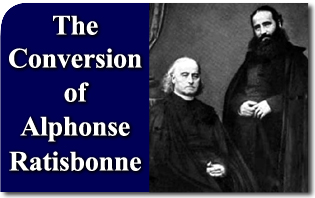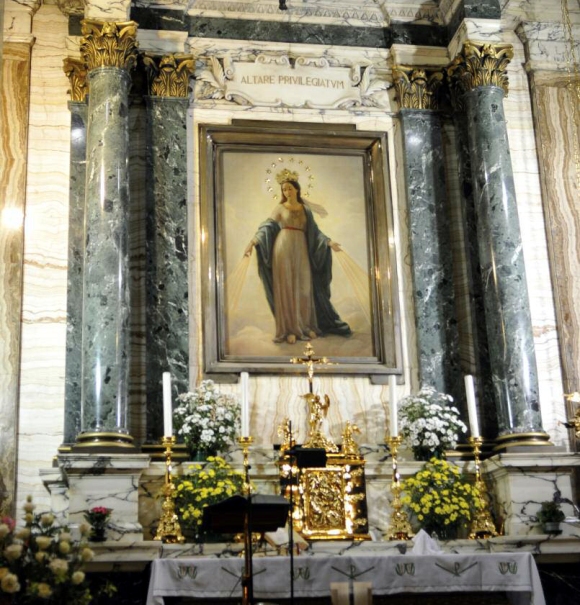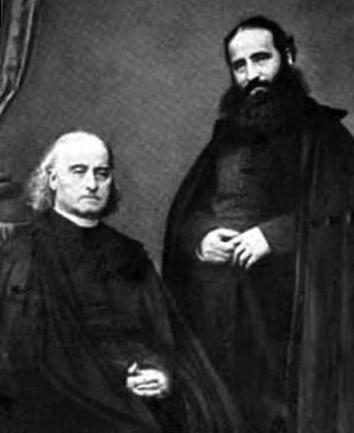by Armando Santos

Alphonse Ratisbonne was a young Jew from a family of well-established bankers in Strasbourg, France. He also was socially prominent due to his wealth and blood-ties to the Rothschild.
In 1827, Alphonse’s older brother, Thèodore, converted to Catholicism and entered the priesthood, thus breaking with his family whose hopes now lay in the young Alphonse, born in 1814.
Alphonse was intelligent and well mannered, had already finished his law degree and was engaged to a young Jewess, his niece. He was twenty-seven years old and, before marrying, he wanted to travel on holiday to Italy and the East. Upon his return, he planned to marry and take on his responsibilities in his family’s banking business.
God, however, had other plans for him in Rome.
Alphonse was not a practicing Jew. He nourished a profound hatred for the Catholic Church, especially because of the resentment his whole family had due to their first-born’s defection. Alphonse said he would never change religion. But if one day he were to change, he would become a Protestant, never a Catholic.
While in Rome, Ratisbonne visited works of art, as well as some Catholic churches, out of cultural curiosity. These visits hardened his anti-Catholic stance.
He also visited an old schoolmate and close friend named Gustave de Bussières. Gustave was a Protestant and several times had tried, in vain, to win Alphonse over to his religious convictions. In Gustave’s house, Alphonse was introduced to Gustave’s brother, Baron Thèodore de Bussières, who had just recently converted to Catholicism. Baron Thèodore, in turn, was a close friend of Father Thèodore Ratisbonne. Because of these two circumstances, Alphonse greatly disliked him.
Thus it was only on the eve of his departure that he reluctantly resolved to fulfill his social obligation to leave his calling card at the Baron’s house as a farewell gesture.
Hoping to avoid a meeting, Alphonse intended to leave his card discreetly and depart straight away. The Baron’s Italian servant, however, did not understand his French and showed him into the parlor while he went to call the Baron. The latter greeted the young Jew and immediately established cordial relations, while trying to attract him to the Catholic Faith.
With much insistence, he was able to persuade Alphonse to delay his departure from Rome in order to attend a ceremony to be held at Saint Peter’s Basilica. He further succeeded in persuading Ratisbonne to accept a Miraculous Medal and to promise to copy down a very beautiful prayer: the Memorare. Had this not been inspired by grace, it would have been utterly indiscreet.
The Jew could hardly contain his anger at the Baron’s boldness of proposing these things to him, but decided to take everything good-heartedly, hoping, as he later declared, to write a book about his travels. In this book, the Baron would appear as nothing more than an eccentric man.
On January 18, a close friend of the Baron de Bussières died. He was Count de La Ferronays, the former French ambassador to the Holy See and a man of great virtue and piety. On the eve of his sudden death, La Ferronays was talking to Bussières about Ratisbonne and, at the request of Bussières, prayed the Memorare one hundred times for his conversion. It is even possible that he offered his life to God for the conversion of the young banker.
The side altar of the Church of Saint Andrea delle Fratte. To the left a small plaque reads, “Alphonse Ratisbonne of Strasbourg, an obstinate Jew, came here. This Virgin appeared to him as you see her; falling on his knees a Jew, he rose a Christian.”
Around midday on January 20, the Baron de Bussières went to the church of Sant’Andrea delle Fratte to arrange for his deceased friend’s funeral to be held the following day. Ratisbonne reluctantly went along making violent criticisms of the Church and mocking Catholic practices. When they arrived at the church, the Baron left him alone for a few minutes and entered the sacristy to see about the funeral arrangements. Alphonse decided to look around and went up one of the side aisles since he could not cross over due to the preparations for the Count’s funeral in the central nave.
When the Baron returned just a few minutes later, he did not find Alphonse where he had left him. After much searching, he found him on the other side of the Church kneeling close to an altar, weeping. He no longer found a Jew, but a convert who ardently desired baptism.
Ratisbonne himself tells us what happened in those few minutes:
“I had only been in the church a short while when, all of a sudden, I felt totally uneasy for no apparent reason. I raised my eyes and saw that the whole building had disappeared. Only one side chapel had, so to say, gathered all the light. In the midst of this splendor, the Virgin Mary appeared standing on the altar. She was grandiose, brilliant, full of majesty and sweetness, just as she is in the Miraculous Medal. An irresistible force attracted me to her. The Virgin made a gesture with her hand indicating I was to kneel and as if saying ‘very good!’ Although she did not say anything, I understood everything.”
Ratisbonne never could explain how, being in one of the lateral naves before the apparition, he was found in the other, since the central nave was obstructed. However, in face of themagnitude of the miracle of his conversion, this was but a detail.
The news of such an unexpected conversion, so fulminating and complete, immediately spread and caused a great commotion throughout Europe.
Alphonse (right) and his brother Theodore founded the Congregation of Our Lady of Sion for the conversion of Jews.
Pope Gregory XVI wished to meet the young convert and received him paternally. He ordered a detailed investigation with all the rigor required by canon law. The conclusion was that it was truly an authentic miracle.
Having taken the name Maria Alphonse at baptism, Ratisbonne wished to become a Jesuit and was ordained in 1847. After a while and at the suggestion of Blessed Pope Pius IX, he left the Jesuits and joined his brother Thèodore in founding the Congregation of Our Lady of Sion, dedicated to the conversion of the Jews.
Father Theodore spread his congregation throughout France and England, while Father Maria Alphonse went to the Holy Land. In Jerusalem he bought a plot of land where the praetorium of Pilate had formerly stood. Here he established a house of the congregation. The two brothers died in 1884, both with the fame of exceptional virtues.



No comments:
Post a Comment